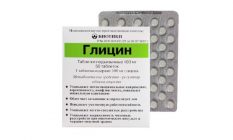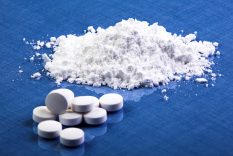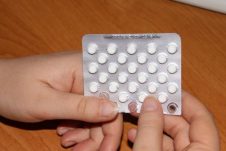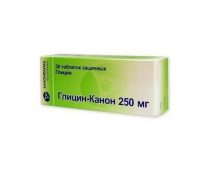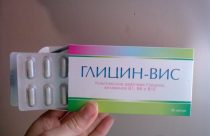Residents of modern cities face various stressful situations every day. The frantic rhythm of life with constant rush, round-the-clock noise of the streets, the mass of information that falls on your head does not positively affect your well-being. Tune in a calm working mood will help the drug "Glycine." How exactly does this medicine work, when and how to take it and what to consider when taking it - you will find answers to questions in the article.
Material Content:
Composition, drug release form
The main component of the drug is aminoacetic acid. Under normal conditions, it is produced in sufficient quantities in the human body. The substance affects the productivity of the brain and regulates the processes of the nervous system, providing a quick recovery of the emotional state in stressful situations.
But due to constant stress, increased mental and physical stress, the need for aminoacetic acid increases, and a weakened body is not able to independently make up for the loss.
It is in this case that the sweet white Glycine pills come to the rescue, which are taken sublingually. The dosage of the drug presented in the pharmacy network is diverse, so that you can choose the option for any age. In packs of 50 pieces are tablets with 100, 150, 400 or 500 mg of active substance.
The tablet form also contains methyl cellulose and magnesium stearate.
Pharmacological properties and pharmacokinetics
The amino acid focuses on improving the state of the nervous system, which can not cope with the increased load. A neurotropic drug helps a person adapt to environmental conditions.

It has a complex effect due to its special properties:
- antioxidant;
- adrenergic blocking;
- neuroprotective;
- antitoxic.
Acid:
- increases the protective functions of the central nervous system;
- relieves high tone, emotional stress;
- stimulates the metabolism;
- makes the brain work more actively and productively;
- increases the degree of mood;
- improves the processes of memorization, perception of information;
- relieves nervousness, aggressiveness;
- eliminates sleep problems;
- stimulates the withdrawal of toxic decomposition products of alcohol and drugs;
- reduces the risk of complications after traumatic brain injury and cerebral hemorrhage;
- normalizes hormonal balance;
- gives vitality and energy.
The natural origin of the drug allows the active substance to be immediately absorbed by all body tissues, achieving the desired effect in a matter of minutes after administration.
The drug is safe, because it does not accumulate, but quickly disintegrates into carbon dioxide and water and in this form is excreted by the kidneys.
Why is the drug prescribed?
The drug is used to stimulate the effective functioning of the brain. And since it is responsible for the functionality of all body systems, the effect of the drug is more extensive.
"Glycine" is needed in such cases:
- decreased mental performance;
- trouble concentrating;
- chronic fatigue syndrome;
- prolonged stress;
- neurotic pathologies accompanied by aggression and increased excitability;
- sclerosis in the elderly;
- encephalopathy of various origins;
- childhood crises;
- signs of vegetative-vascular dystonia;
- prevention of depressed mood;
- hormonal disorders during PMS, menopause in women;
- ischemic stroke;
- neuroinfection;
- recovery after traumatic brain injury;
- problems with the prostate in men;
- increased craving for sweets;
- impaired metabolism;
- pathology of the liver and kidneys;
- high sugar level.
Another area of application of the drug is the beauty of the skin and hair. Active amino acid increases the amount of collagen. It eliminates the first signs of aging, makes skin radiant and elastic curls.
Also, the tool helps to accumulate body forces for the best result for students in exams and athletes in competitions.
Instructions for use and dosage of glycine
Depending on the indications and age of the patient, doctors indicate the duration of treatment and the daily dose of the drug.
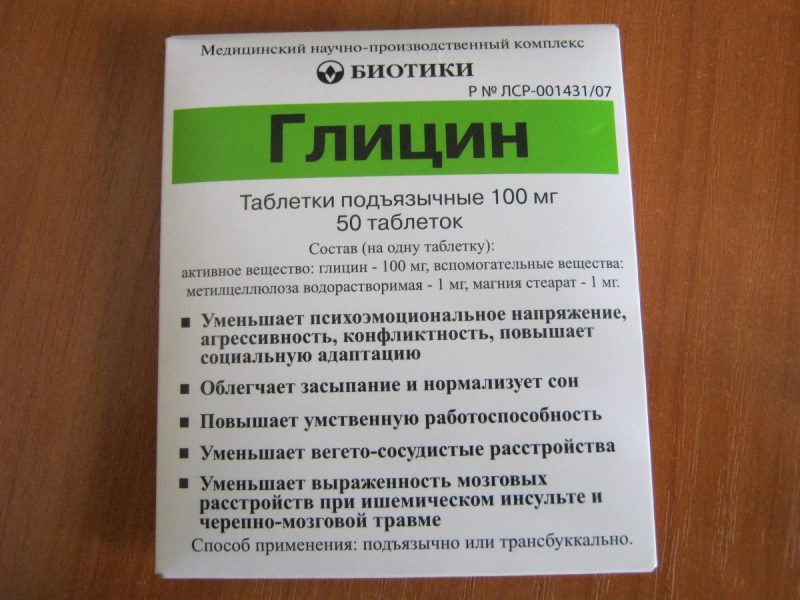
The manufacturer recommends adhering to the standard dosage in the instructions if the doctor has not adjusted it. The regimen is based on the fact that in one tablet is 100 mg of aminoacetic acid.
For adults
Most often, adults “Glycine” is recommended to take 1 tablet 2 or 3 times a day. In this case, the duration of the course of therapy depends on the disease or condition in which the medicine is indicated.
- If there are problems with remembering and concentration, regardless of young or old age, take pills should be from 2 weeks to 1 month.
- When there is a need for additional mental work in order to improve the performance of the brain, a course of two to three weeks is prescribed.
- In case of nervous disorders, which is manifested by excessive aggressiveness and intolerance, tablets should be drunk for a week or two, until symptoms improve. After a month break, it is recommended to repeat such a course.
- If a person is in a stressful situation for a long time, when emotional stress goes off scale, amino acid therapy for 14-30 days will significantly improve the condition.
- For the treatment of drug or alcohol dependence, the course of the drug is 1 month.
- In case of brain injuries, therapy is 14 days.
- The course of treatment for the phenomena of encephalopathy is from 14 to 30 days. At the same time, 5-6 such courses can be conducted throughout the year.
If a person has problems falling asleep, then for this it is enough to take 1 tablet before going to bed in 20 to 30 minutes.
And completely different doses are necessary in case of manifestation of ischemia, after an attack of a stroke. It is necessary in the first period after the incident (for 3 - 5 hours) to dissolve 10 pills. Over the next five days, the dosage is 10 tablets per day, and another month you need to drink 2 pills three times a day.
For children
Admission is allowed for babies from the age of two in order to eliminate signs of deviant behavior and improve concentration.
Dosage up to 3 years is half the pill, and older patients need to take the whole pill. Standard regimen: two or three times a day for one to two weeks.
In special cases, the medicine should be given to infants. Then the mother takes the drug, and with the milk he gets the child.
Special instructions for admission
Pills do not need to be swallowed, because if you expect that absorption will occur in the stomach or intestines, then a lot of time will pass. In addition, under the influence of gastric juice, some useful properties of the drug are lost.
It is necessary to ensure a quick effect, which is why the pills should be absorbed under the tongue so that the amino acid enters the blood vessels through the tissues of the oral cavity.
In emergency situations, when stress causes a heart attack, heart rhythm failure, or other pathologies, doctors recommend taking the drug buccally. This method involves grinding the pills into a fine powder and then rubbing it into the gums or the inside of the cheeks. This increases the rate of absorption, and faster the improvement occurs.
The drug can be taken at any time of the day, regardless of the meal, because the digestion processes do not affect the effectiveness of the drug.
Use during pregnancy and lactation
The gestation period brings fundamental changes to the life of a woman. Indeed, from the moment of conception to the birth of the child, the mother’s body gives in to a huge number of transformations.

And often the nervous system simply does not have time for all these changes. Therefore, pregnant women are prone to causeless mood swings, tears, agitation, or depressive emotions.
Aminoacetic acid is able to improve the condition of future mothers, and at the same time, and contribute to the normal development of the baby in the womb.
It is useful for pregnant women to take Glycine if:
- headache often;
- jumps blood pressure;
- stressful situations appear;
- sleep patterns are disturbed;
- memory deteriorates;
- blood cholesterol increases;
- the body succumbed to intoxication.
The standard dosage for pregnant women is 100 mg of the drug 3 times a day. But you can not start a course of treatment yourself, only after consulting a doctor who will determine the dosage and duration of therapy.
During the first trimester, doctors generally do not recommend taking medications so as not to harm the normal development of the fetus.
Drug Interactions with Other Drugs
Since the acid is natural for the human body, there is no special interaction with medications.
Among the small influences, the ability of the drug to reduce the toxicity of anticonvulsants is noted.
And if you take the medicine along with similar drugs in its effect, then there is a risk of overdose, which causes inhibition of the nervous system.
Among these drugs:
- sleeping pills;
- tranquilizers;
- antipsychotics;
- sedatives;
- antidepressants.
Starting the course of treatment, the compatibility and interaction of these drugs should be considered.
Contraindications, side effects and overdose
Almost the only serious contraindication to the use of the drug is individual intolerance to amino acids. But this phenomenon happens very rarely, because the active component of the drug is an essential component of the human body.

Also with caution should be taken "Glycine":
- pregnant in the first trimester;
- children under 2 years old;
- people with low blood pressure.
Among the side effects of the drug are indicated:
- decrease in blood pressure;
- drowsiness;
- lethargy;
- nausea.
If you increase the recommended dose, then unpleasant symptoms occur:
- sharp abdominal pain;
- fatigue;
- pallor of the skin.
There are few cases of overdose. In such a situation, symptomatic therapy is necessary. If it does not get better, immediately consult a doctor.
Glycine analogues
In addition to the usual drug, there are drugs enriched with B vitamins in combination with aminoacetic acid.
It:
- "Glycine Forte" of the company "Evalar" - in tablets of 300 and 600 mg;
- "Glycine-Vis" - in a dosage of 400 mg;
- "Glycine-Canon" - pills of 1000 mg of active substance.
Glycine-Bio and Glyciced contain 100 mg of aminoacetic acid.
If for some reason the patient can not use drugs of this synonymous series, the doctor prescribes medicines that are similar in effect.
Among them:
- "Mexidol" with ethyl methyl ethyl hydroxypyridine succinate;
- Borizol having riluzole;
- glutamic acid;
- "Instenon" with hexobendine, ethivian and etophylline;
- "Celtican" with uridine;
- "Cytoflavin" with inosine, riboflavin and nicotinamide.
In any case, it is necessary to take into account contraindications and features of the action of each of the medicines in order to ensure safety and effectiveness.









